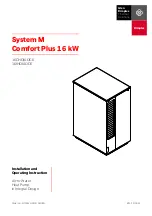
ENGLISH
56
menu pages, the ^ and
˅
keys allow you respectively to increase and decrease the value of the parameter concerned. Press SET to leave this
menu and return to the main menu.
8.6.1
TB: Water lack blockage time
Setting the reaction time of the water lack blockage allows you to select the time (in seconds) taken by the device to indicate the lack of water.
The variation of this parameter may be useful if there is known to be a delay between the moment the motor is switched on and the moment it
actually begins to deliver. One example may be a plant where the suction pipe is particularly long and there are some slight leaks. In this case
the pipe in question may be discharged and, even though water is not lacking, the electropump will take a certain time to reload, supply the flow
and put the plant under pressure.
8.6.2
T1: Low pressure delay (kiwa function)
Sets the time when the inverter switches off after receiving the low pressure signal (see Setting low pressure detection par 9.6.15.5). The low
pressure signal can be received on each of the 4 inputs by suitably configuring the input (see Setup of auxiliary digital inputs IN1, IN2, IN3, IN4
par 9.6.15).
T1 can be set between 0 and 12 s. The factory setting is 2 s.
8.6.3
T2: Delay in switching off
Sets the delay with which the inverter must switch off after switch-off conditions have been reached: plant under pressure and flow rate lower
than the minimum flow.
T2 can be set between 2 and 120 s. The factory setting is 10 s.
8.6.4
GP: Proportional gain coefficient
Generally the proportional term must be increased for systems characterised by elasticity (for example with PVC pipes) and lowered in rigid
systems (for example with iron pipes). To keep the pressure in the system constant, the inverter performs a type PI control on the measured
pressure error. Depending on this error the inverter calculates the power to be supplied to the motor. The behaviour of this control depends on
the set GP and GI parameters. To cope with the different behaviour of the various types of hydraulic plants where the system can work, the
inverter allows the selection of parameters different from those set by the factory. For nearly all plants the factory-set GP and GI parameters are
optimal. However, should any problems occur in adjustment, these settings may be varied.
8.6.5
GI: Integral gain coefficient
In the presence of large falls in pressure due to a sudden increase of the flow or a slow response of the system, increase the value of GI.
Instead, if there are swings in pressure around the setpoint value, decrease the value of GI.
IMPORTANT:
To obtain satisfactory pressure adjustments, you generally have to adjust both GP and GI.
8.6.6
RM: Maximum speed
Sets a maximum limit on the number of pump revolutions.
8.6.7
Setting the number of devices and of reserves
8.6.8
NA: Active devices
Sets the maximum number of devices that participate in pumping.
It may have values between 1 and the number of devices present (max 4). The default value for NA is N, that is the number of devices present
in the chain; this means that if devices are added to or removed from the chain, NA always has the value of the number of devices present,
automatically detected. If a number different from N is set, this fixes the maximum number of devices that can participate in pumping at the
number set.
This parameter is used in cases where there is a limit on the pumps you can or want to be able to keep running, and if you want to keep one or
more devices as a reserve (see 8.6.10 IC: Configuration examples for multi-pump plants below).
On the same menu page you can also see (but not change) the other two system parameters linked to this, that is N, the number of devices
present, acquired automatically by the system, and NC, the maximum number of simultaneous devices.
8.6.9
NC: Simultaneous devices
Sets the maximum number of devices that can work at the same time. It may have values between 1 and NA. The default value of NC is NA,
this means that even if NA increases, NC will have the value NA. If a number different from NA is set, this releases you from NA and fixes the
maximum number of simultaneous devices at the number set. This parameter is used in cases where there is a limit on the pumps you can or
want to be able to keep running (see 8.6.10 IC: Configuration examples for multi-pump plants below).
On the same menu page you can also see (but not change) the other two system parameters linked to this, that is N, the number of devices
present, read automatically by the system, and NA, the number of active devices.
















































